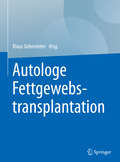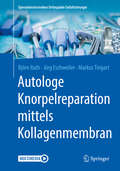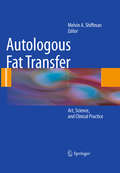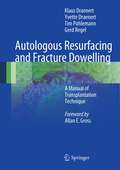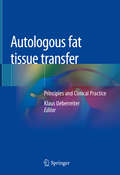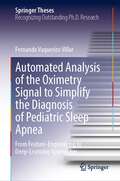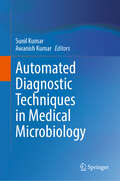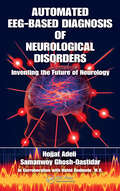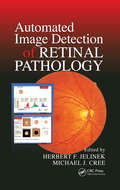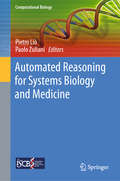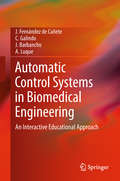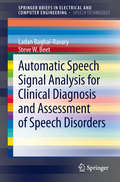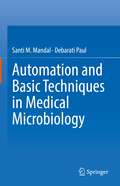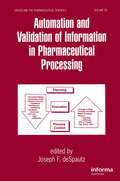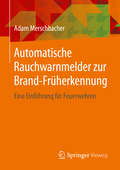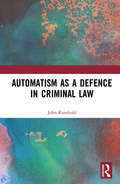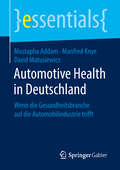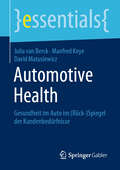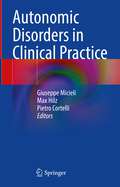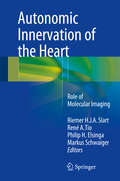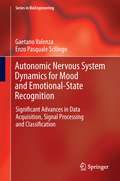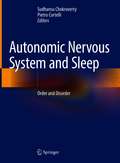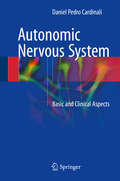- Table View
- List View
Autoimmunity: Methods and Protocols (Methods in Molecular Medicine #102)
by Andras Perl“Research is to see what everybody else has seen, and to think what nobody else has thought. ” — Albert Szentgyörgyi Autoimmunity: Methods and Protocols is intended to serve as a ready-to-use guide to establish and interrogate human and animal models of autoimmune diseases. The first chapter, “Pathogenesis and Spectrum of Autoimmunity,” discusses major hypotheses driving this most tantalizing area of research since Paul Ehrlich proposed the concept of autoimmunity in 1900. Considering the great diversity and ever-changing spectrum of autoimmunity, it has not been possible to include models and experimental protocols for each known disorder. Rather, several chapters have been devoted to the most prevalent and complex diseases, such as rheumatoid arthritis, systemic lupus erythematosus, insulin-dependent diabetes mellitus, and multiple sclerosis. The chapters are contributed by laboratories actively using the models presented. Each chapter contains an introductory section that discusses the relevance of the model for a particular disease and for autoimmunity in general. Part I contains methods and protocols to assess immunological and biochemical pathways relevant for disease pathogenesis. Chapters in this section focus on methods to identify susceptibility genes, intercellular signaling via cytokines, intracellular signaling through the T-cell receptor and signal processing via protein kinases, identification and enumeration of autoantigen-specific T cells and autoantibodies, and the dysregulation of apoptosis and its role in modification of self-antigens. Part II contains protocols to establish and assess inflammatory arthritis, systemic lupus erythematosus, myocarditis, thyroiditis, experimental autoimmune encepha- myelitis, insulin-dependent diabetes mellitus, scleroderma, uveitis, and vitiligo.
Autologe Fettgewebstransplantation
by Klaus UeberreiterDas Buch beschreibt die Eigenfetttransplantation bei Falten, Brustvergrößerung, Brustaufbau nach Ablatio, Augmentation des Mittelgesichts, Narben, chronischen Wunden, Glutealaugmentation, Handverjüngung und weiteren Indikationen. Alle Techniken des autologen Fettgewebstransfers, wie BEAULI, Coleman, Shippert und Khouri werden mit Hinweisen für eine erfolgreiche Transplantatgewinnung und Reinjektion erklärt. Ergänzt wird das Buch durch Kapitel über Voraussetzungen seitens der Patienten, Patientenaufklärung, Behandlungsdokumentation, Nachbehandlung und objektive Bewertung des Ergebnisses durch volumetrische Dokumentation. Durch eine praxisnahe Darstellung mit vielen Abbildungen lassen sich die Informationen in diesem Buch sofort in der täglichen Arbeit einsetzen. Für Plastische und Ästhetische Chirurgen, Dermatologen, MKG-Chirurgen, Gynäkologen und alle anderen in der ästhetischen Chirurgie tätigen Fachärzte, die rekonstruktive oder ästhetische Eigenfettbehandlung in ihrem Behandlungsportfolio haben.
Autologe Knorpelreparation mittels Kollagenmembran (Operationstechniken Orthopädie Unfallchirurgie)
by Markus Tingart Jörg Eschweiler Björn RathDas Buch beschreibt das innovative, zellfreie Verfahren der AMIC Plastik zur Rekonstruktion von Knorpeldefekten am Kniegelenk. Eingangs werden wichtige Hinweise zur Klassifikation von Knorpeldefekten und der korrekten Indikationsstellung in Abhängigkeit der Defektgröße und –lage gegeben. Der Fokus des Buchs liegt auf der operativen Durchführung der AMIC-Plastik. Sie wird in detaillierten Grafiken und hochauflösenden Abbildungen visualisiert. Darüber hinaus wird die Operationstechnik in einem ca. 10-minütigen Video anschaulich, Schritt für Schritt und inklusive vieler wichtiger Tipps demonstriert.
Autologous Fat Transfer: Art, Science, and Clinical Practice
by Melvin A. ShiffmanThis book covers all aspects of autologous fat transfer including the history of fat transfer, the history of autologous fat survival, a variety of aesthetic and plastic procedures of the face and body, noncosmetic applications of fat transfer, preoperative care, complications, and medical-legal aspects. The contributors are international experts in the field of autologous fat transfer.
Autologous Resurfacing and Fracture Dowelling: A Manual of Transplantation Technique
by Gerd Regel Klaus Draenert Tim Pohlemann Yvette DraenertThis book describes in detail a unique and very precise operative technique that uses autologous cartilage/bone grafts for the reconstruction of load-bearing joint surfaces and for dowelling of non-unions. The technique, employing diamond instruments and a wet grinding process, has been developed and refined over the past 30 years at the Center for Orthopaedic Sciences (ZOW), first in Bern and later in Munich. A step-by-step description of the method is provided for each indication, with the aid of many high-quality illustrations. Correctly applied, the technique has been very successful in restoring high-level athletes to competition; it can be applied even in "hopeless cases" and offers excellent late results. This guide will be invaluable for orthopaedic surgeons wishing to master this proven and effective approach.
Autologous fat tissue transfer: Principles and Clinical Practice
by Klaus UeberreiterThis book describes the latest autologous fat transfer techniques used in connection with wrinkles, breast augmentation, breast reconstruction after ablation, middle face augmentation, scars, chronic wounds, gluteal augmentation and rejuvenation of the hand. All autologous fat transfer techniques, such as BEAULI, Coleman, Shippert, and Khouri, are explained with regard to successful transplantation and reinjection. Further, the book includes chapters on patient prerequisites, patient education, treatment documentation, and objective post-treatment assessment of the outcome using volumetric documentation. The practical presentation of the information, together with a wealth of illustrations, makes this book a valuable guide for plastic and aesthetic surgeons, dermatologists, oral and maxillofacial surgeons, gynecologists and all other specialists in aesthetic surgery who offer reconstructive or aesthetic autologous treatments.
Automated Analysis of the Oximetry Signal to Simplify the Diagnosis of Pediatric Sleep Apnea: From Feature-Engineering to Deep-Learning Approaches (Springer Theses)
by Fernando Vaquerizo VillarThis book describes the application of novel signal processing algorithms to improve the diagnostic capability of the blood oxygen saturation signal (SpO2) from nocturnal oximetry in the simplification of pediatric obstructive sleep apnea (OSA) diagnosis. For this purpose, 3196 SpO2 recordings from three different databases were analyzed using feature-engineering and deep-learning methodologies. Particularly, three novel feature extraction algorithms (bispectrum, wavelet, and detrended fluctuation analysis), as well as a novel deep-learning architecture based on convolutional neural networks are proposed. The proposed feature-engineering and deep-learning models outperformed conventional features from the oximetry signal, as well as state-of-the-art approaches. On the one hand, this book shows that bispectrum, wavelet, and detrended fluctuation analysis can be used to characterize changes in the SpO2 signal caused by apneic events in pediatric subjects. On the other hand, it demonstrates that deep-learning algorithms can learn complex features from oximetry dynamics that allow to enhance the diagnostic capability of nocturnal oximetry in the context of childhood OSA. All in all, this book offers a comprehensive and timely guide to the use of signal processing and AI methods in the diagnosis of pediatric OSA, including novel methodological insights concerning the automated analysis of the oximetry signal. It also discusses some open questions for future research.
Automated Diagnostic Techniques in Medical Microbiology
by Sunil Kumar Awanish KumarThis book will explore the knowledge of current diagnostic automation techniques applied in the field of clinical microbiology, tropical diseases, POCT, etc. There is no such type of book related to this topic. This book will help clinicians, microbiologists, and researchers to make diagnostic algorithms for infectious diseases and help them in early diagnosis. Automation in clinical microbiology has revolutionized routine practice in diagnostic cum research in medical microbiology. This book covers the recent updates and advances in diagnostic microbiology and provides new techniques related to Genomic, Proteomic, and metabolomics in microbiology. This book will intensely discuss the new and innovative automation techniques available for diagnosis in the microbiology laboratory. This book is more focused on automation techniques, which are used in the early detection of infectious diseases even caused by rare microorganisms. Furthermore, this book has complied with the chapters that provide insights to readers with comprehensive and usable knowledge on automation techniques in diagnostic microbiology.
Automated EEG-Based Diagnosis of Neurological Disorders: Inventing the Future of Neurology
by Hojjat Adeli Samanwoy Ghosh-DastidarBased on the authors' groundbreaking research, Automated EEG-Based Diagnosis of Neurological Disorders: Inventing the Future of Neurology presents a research ideology, a novel multi-paradigm methodology, and advanced computational models for the automated EEG-based diagnosis of neurological disorders. It is based on the ingenious integration of thr
Automated Image Detection of Retinal Pathology
by Herbert Jelinek Michael J. CreeDiscusses the Effect of Automated Assessment Programs on Health Care ProvisionDiabetes is approaching pandemic numbers, and as an associated complication, diabetic retinopathy is also on the rise. Much about the computer-based diagnosis of this intricate illness has been discovered and proven effective in research labs. But, unfortunately, many of
Automated Reasoning for Systems Biology and Medicine (Computational Biology #30)
by Pietro Liò Paolo ZulianiThis book presents outstanding contributions in an exciting, new and multidisciplinary research area: the application of formal, automated reasoning techniques to analyse complex models in systems biology and systems medicine. Automated reasoning is a field of computer science devoted to the development of algorithms that yield trustworthy answers, providing a basis of sound logical reasoning. For example, in the semiconductor industry formal verification is instrumental to ensuring that chip designs are free of defects (or “bugs”). Over the past 15 years, systems biology and systems medicine have been introduced in an attempt to understand the enormous complexity of life from a computational point of view. This has generated a wealth of new knowledge in the form of computational models, whose staggering complexity makes manual analysis methods infeasible. Sound, trusted, and automated means of analysing the models are thus required in order to be able to trust their conclusions. Above all, this is crucial to engineering safe biomedical devices and to reducing our reliance on wet-lab experiments and clinical trials, which will in turn produce lower economic and societal costs. Some examples of the questions addressed here include: Can we automatically adjust medications for patients with multiple chronic conditions? Can we verify that an artificial pancreas system delivers insulin in a way that ensures Type 1 diabetic patients never suffer from hyperglycaemia or hypoglycaemia? And lastly, can we predict what kind of mutations a cancer cell is likely to undergo? This book brings together leading researchers from a number of highly interdisciplinary areas, including: · Parameter inference from time series · Model selection · Network structure identification · Machine learning · Systems medicine · Hypothesis generation from experimental data · Systems biology, systems medicine, and digital pathology · Verification of biomedical devices “This book presents a comprehensive spectrum of model-focused analysis techniques for biological systems ...an essential resource for tracking the developments of a fast moving field that promises to revolutionize biology and medicine by the automated analysis of models and data.”Prof Luca Cardelli FRS, University of Oxford
Automated Technologies for the Development and Production of Radiopharmaceuticals
by Yuji Kuge R. Michael van Dam Giancarlo PascaliThis is the first comprehensive book about the advanced technologies used in the radiopharmaceutical field. It covers each major area of radiopharmaceutical preparation, including radioisotope production and separation, multi-step radiosynthesis, analysis and quality control of the products as well as technologies for novel radiopharmaceutical development. Chapters are written by leaders in the field and comprehensively describe the evolution of relevant technologies, the current state-of-the-art, and future directions. The book will be an invaluable tool for researchers in radiochemistry or radiopharmaceutical development, disease researchers, and pharmaceutical researchers developing new drugs using in vivo imaging techniques in the drug development process.
Automatic Control Systems in Biomedical Engineering: An Interactive Educational Approach
by J. Fernández de Cañete C. Galindo J. Barbancho A. LuqueThis book presents the fundamental principles and challenges encountered in the control of biomedical systems, providing practical solutions and suggesting alternatives. The perspective of the text is based on the system behaviour in the time domain both linear and non-linear, continuous and discrete, helping the reader to be able to interpret the physical significance of mathematical results during control system analysis and design focusing on biomedical engineering applications. Interactive learning is promoted, endowing students with the ability to change parameters and conditions during the simulation and see the effects of these changes, by using interactive MATLAB and SIMULINK software tools, also presenting realistic problems in order to analyse, design and develop automatic control systems. The text is also complemented with MATLAB and SIMULINK exercise files solved to aid students to focus on the fundamental concepts treated throughout the book, following a new pedagogical approach distinct from the classical one whereby fundamental control concepts are introduced together with adequate software tools in order to gain insight on the biomedical engineering control problems. The book is suitable for second or third-year undergraduate students who will find the illustrative examples particularly useful to their studies of control system design and implementation. Lecturers in the control field will find the computer aided design approach as an alternative to teaching the fundamental concepts of feedback analogic and digital control.
Automatic Speech Signal Analysis for Clinical Diagnosis and Assessment of Speech Disorders (SpringerBriefs in Speech Technology)
by Steve W. Beet Ladan Baghai-RavaryAutomatic Speech Signal Analysis for Clinical Diagnosis and Assessment of Speech Disorders provides a survey of methods designed to aid clinicians in the diagnosis and monitoring of speech disorders such as dysarthria and dyspraxia, with an emphasis on the signal processing techniques, statistical validity of the results presented in the literature, and the appropriateness of methods that do not require specialized equipment, rigorously controlled recording procedures or highly skilled personnel to interpret results. Such techniques offer the promise of a simple and cost-effective, yet objective, assessment of a range of medical conditions, which would be of great value to clinicians. The ideal scenario would begin with the collection of examples of the clients' speech, either over the phone or using portable recording devices operated by non-specialist nursing staff. The recordings could then be analyzed initially to aid diagnosis of conditions, and subsequently to monitor the clients' progress and response to treatment. The automation of this process would allow more frequent and regular assessments to be performed, as well as providing greater objectivity.
Automation and Basic Techniques in Medical Microbiology
by Santi M. Mandal Debarati PaulThis book discusses principles, methodology, and applications of microbiological laboratory techniques . It lays special emphasis on the use of various automated machines that are essential for medical microbiology and diagnostic labs. The book contains eleven major chapters. The first chapter describes the good lab practices which should be followed by the students in all biological, chemistry or microbiology laboratories. The next chapter describes manual and automated characterization of antibiotic resistant microbes, followed by a chapter on genomics based tools and techniques that are integral to research. Further chapters deal with other important techniques like immunology based techniques, spectrophotometry and its various types, MALDI-TOFF and microarrays, each with illustrations and detailed description of the protocols and applications. The book also gives certain important guidelines to the students about the planning the experiment and interpreting results.The book is highly informative and provides latest techniques. It is a handy compendium for graduate and post graduate students, as well as more advanced researchers.
Automation and Validation of Information in Pharmaceutical Processing (Drugs and the Pharmaceutical Sciences)
by Joseph F. deSpautzThis thoroughly authoritative work furnishes organizational, technological, validation, project management, and business perspectives on pharmaceutical information automation from industry and system automation professionals-demonstrating how to fulfill computer system validation requirements for hardware, applications, networks, data center operat
Automatische Rauchwarnmelder zur Brand-Früherkennung: Eine Einführung für Feuerwehren
by Adam MerschbacherDieses Buch soll dazu beitragen, dass Rauchmelder durch Auswahl und Montage zuverlässig Schäden und Rauchopfer, sowie Falschmeldungen vermeiden. Außerdem schafft es Klarheit darüber, wer für was verantwortlich ist.
Automatism as a Defence
by John RumboldAutomatism is a notoriously difficult subject for law students, lawyers and judges. This book explores the science and medicine of sleep disorders and examines how the criminal process deals with such disorders when presented as a defence. It systematically examines the legal doctrines involved, and their implications for the use of the evidence key to establishing automatism, while also exploring the medical conditions that can cause automatism (particularly epilepsy, sleepwalking and diabetes). This book is a valuable resource for law students, lawyers, judges and expert witnesses.
Automotive Health in Deutschland: Wenn die Gesundheitsbranche auf die Automobilindustrie trifft (essentials)
by David Matusiewicz Mustapha Addam Manfred KnyeAutomotive Health ist ein neuartiges innovatives und ggf. disruptives Geschäftsmodell der Gesundheitswirtschaft, welches die zwei bislang völlig unabhängigen Bereiche Mobilität und Gesundheit verknüpft. Automotive Health umfasst Gesundheitsdienstleistungen im Auto, wie beispielsweise die Auswertung von Vitaldaten der Insassen eines Automobils zur Früherkennung von Erkrankungen. Gegenstand des hier vorgestellten Buches ist eine Übersicht des Status Quo zum Thema Automotive Health in Deutschland und Umgebung. Die Ausarbeitung beschäftigt sich mit Veränderungen von Geschäftsmodellen und deren Philosophie in der Digitalen Gesundheit. Es werden aktuelle und zukunftsorientierte Anwendungsszenarien sowie Chancen und Grenzen dieses Themas aufgezeigt und diskutiert.
Automotive Health: Gesundheit im Auto im (Rück-)Spiegel der Kundenbedürfnisse (essentials)
by David Matusiewicz Manfred Knye Julia van BerckAutomotive Health ermöglicht den Menschen, ihre Gesundheit während der Fahrt zu erfassen und damit präventive oder kurative Maßnahmen einzuleiten. Das Konzept unterstützt dabei den selbstbestimmten Umgang mit der eigenen Gesundheit. In diesem essential werden die Ergebnisse einer empirischen Studie vorgestellt, die die Kundenbedürfnisse nach Automotive Health untersucht und herausgestellt hat, welchen Einfluss z. B. der Gesundheitszustand oder die digitale Affinität auf die Nutzenbereitschaft von digitalen Gesundheitsangeboten im Auto haben.Die Autoren:Julia van Berck M.Sc. ist Projektmanagerin für Kooperationen im Gesundheits- und Sozialwesen an der FOM Hochschule für Oekonomie & Management. Dr. med. Manfred Knye ist Leiter des Projekts Einführung Exoskelette, Digitalisierung und Automotive Health der Volkswagen AG und beschäftigt sich mit dem Thema Gesundheit 4.0. Prof. Dr. David Matusiewicz ist Direktor des Instituts für Gesundheit & Soziales (ifgs) und Dekan des Hochschulbereiches Gesundheit & Soziales an der FOM Hochschule für Oekonomie & Management.
Autonomic Disorders in Clinical Practice
by Giuseppe Micieli Pietro Cortelli Max HilzThis book is focused on a clinical-based diagnostic approach of autonomic dysfunctions, highlighting main diagnostic tools and pharmacological and non-pharmacological therapies available nowadays. The autonomic nervous system (ANS) is a subcomponent of the peripheral nervous system (PNS) and dysfunction of one or more subdivisions of the ANS, when accompanying other diseases, is linked to a worse prognosis of the latter. In some circumstances or when severe, dysfunction of ANS itself results in symptoms and disability. A myriad of factors can cause autonomic dysfunction and more than one can concur even in the same patient; due to the expansive nature of the ANS, patients can be affected by a wide range of conditions. Each chapter is characterized by a similar structure and is devoted to a different dysfunction. For each pathology, the book offers the essential information on mechanisms of action, treatments and outcomes. Written by experts in the research of these disorders, the volume addresses primarily Neurologists, but will be a useful tool also for Gastroenterologists, Ophthalmologists, Urologists, Cardiologists and Internal medicine specialists.
Autonomic Innervation of the Heart: Role of Molecular Imaging
by Riemer H.J.A. Slart René A. Tio Philip H. Elsinga Markus SchwaigerThis book explains in detail the potential value of the hybrid modalities, SPECT-CT and PET-CT, in the imaging of cardiac innervation in a wide range of conditions and diseases, including ischemic heart disease, diabetes mellitus, heart failure, amyloidosis, heart transplantation, and ventricular arrhythmias. Imaging of the brain-heart axis in neurodegenerative disease and stress and of cardiotoxicity is also discussed. The roles of the various available tracers are fully considered, and individual chapters address radiopharmaceutical development under GMP, imaging physics, and kinetic modeling software. Highly relevant background information is included on the autonomic nervous system of the heart and its pathophysiology, and in addition future perspectives are discussed. Awareness of the importance of autonomic innervation of the heart for the optimal management of cardiac patients is growing, and there is an evident need for objective measurement techniques or imaging modalities. In this context, Autonomic Innervation of the Heart will be of wide interest to clinicians, researchers, and industry.
Autonomic Nervous System Dynamics for Mood and Emotional-State Recognition: Significant Advances in Data Acquisition, Signal Processing and Classification (Series in BioEngineering)
by Gaetano Valenza Enzo Pasquale ScilingoThis monograph reports on advances in the measurement and study of autonomic nervous system (ANS) dynamics as a source of reliable and effective markers for mood state recognition and assessment of emotional responses. Its primary impact will be in affective computing and the application of emotion-recognition systems. Applicative studies of biosignals such as: electrocardiograms; electrodermal responses; respiration activity; gaze points; and pupil-size variation are covered in detail, and experimental results explain how to characterize the elicited affective levels and mood states pragmatically and accurately using the information thus extracted from the ANS. Nonlinear signal processing techniques play a crucial role in understanding the ANS physiology underlying superficially noticeable changes and provide important quantifiers of cardiovascular control dynamics. These have prognostic value in both healthy subjects and patients with mood disorders. Moreover, Autonomic Nervous System Dynamics for Mood and Emotional-State Recognition proposes a novel probabilistic approach based on the point-process theory in order to model and characterize the instantaneous ANS nonlinear dynamics providing a foundation from which machine "understanding" of emotional response can be enhanced. Using mathematics and signal processing, this work also contributes to pragmatic issues such as emotional and mood-state modeling, elicitation, and non-invasive ANS monitoring. Throughout the text a critical review on the current state-of-the-art is reported, leading to the description of dedicated experimental protocols, novel and reliable mood models, and novel wearable systems able to perform ANS monitoring in a naturalistic environment. Biomedical engineers will find this book of interest, especially those concerned with nonlinear analysis, as will researchers and industrial technicians developing wearable systems and sensors for ANS monitoring.
Autonomic Nervous System and Sleep: Order and Disorder
by Sudhansu Chokroverty Pietro CortelliThis comprehensive book addresses all elements of the autonomic nervous system (ANS) and sleep interaction, as well as ANS alterations in sleep and how these impact primary and comorbid sleep dysfunction. It meets the market need for a comprehensive text that deals with ANS changes in sleep and how these impact various neurological, medical, and primary sleep disorders. Organized into three parts, the book begins with a review of the foundational bodily systems that participate in coordination of ANS activity with other homeostatic responses such as respiration, cardiovascular reflexes, and responses to stress. Part two then examines methods of laboratory evaluation and the “why, when, how” of interpreting heart rate variability in sleep. To conclude, the final section of the book broadly covers the many clinical aspects of ANS, including insomnia, restless leg syndrome, sleep apnea, sleep related epilepsy, and acute autonomic neuropathy. Autonomic Nervous System and Sleep enhances the reader's understanding of the pathophysiology of various disorders, and explains how to apply this profound understanding is important to new lines of therapy to improve morbidity.
Autonomic Nervous System: Basic and Clinical Aspects
by Daniel Pedro CardinaliA traditional view of the Autonomic Nervous System (ANS) considers only its peripheral part: the sympathetic and parasympathetic systems. However, this view misses to consider the most important ANS function: the maintenance of homeostasis. This term is used today to define not only the strategies that allow the body proper response to changes in the environment (reactive homeostasis), but also temporal mechanisms that allow the body to predict the most likely timing of environmental stimuli (predictive homeostasis based on biological rhythms). This book discusses the ANS from both an enlarged and a timed perspective. First, it presents how the organization of the ANS is hierarchical into different levels. Following that, the book discusses how the ANS changes functionally in the three-body configurations (wakefulness, slow sleep, rapid eye movement sleep) found in a 24-hour cycle. Finally, the most important clinical implications of this enlarged and timed vision of ANS will be discussed. Autonomic Nervous System - Basic and Clinical Aspects is a comprehensive text intended for medical students and health professionals who are interested in a deeper approach to this important part of the nervous system. It provides a detailed and complete understanding of the neuroscience behind the ANS, allowing a proper clinical applicability of this knowledge.

